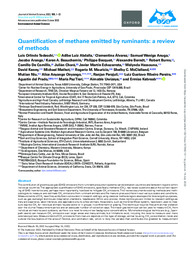Quantifcation of methane emitted by ruminants: a review of methods.
Quantifcation of methane emitted by ruminants: a review of methods.
Autoria: TEDESCHI, L. O.; ABDALLA, A. L.; ÁLVAREZ, C.; ANUGA, S. W.; ARANGO, J.; BEAUCHEMIN, K. A.; BECQUET, P.; BERNDT, A.; BURNS, R.; CAMILLIS, C. de; CHARÁ, J.; ECHAZARRETA, J. M.; HASSOUNA, M.; KENNY, D.; MATHOT, M.; MAURICIO, R. M.; MCCLELLAND, S. C.; NIU, M.; ONYANGO, A. A.; PARAJULI, R.; PEREIRA, L. G. R.; PRADO, A. del; TIERI, M. P.; UWIZEYE, A.; KEBREAB, E.
Resumo: The contribution of greenhouse gas (GHG) emissions from ruminant production systems varies between countries and between regions within individual countries. The appropriate quantifcation of GHG emissions, specifcally methane (CH4), has raised questions about the correct reporting of GHG inventories and, perhaps more importantly, how best to mitigate CH4 emissions. This review documents existing methods and methodologies to measure and estimate CH4 emissions from ruminant animals and the manure produced therein over various scales and conditions. Measurements of CH4 have frequently been conducted in research settings using classical methodologies developed for bioenergetic purposes, such as gas exchange techniques (respiration chambers, headboxes). While very precise, these techniques are limited to research settings as they are expensive, labor-intensive, and applicable only to a few animals. Head-stalls, such as the GreenFeed system, have been used to measure expired CH4 for individual animals housed alone or in groups in confnement or grazing. This technique requires frequent animal visitation over the diurnal measurement period and an adequate number of collection days. The tracer gas technique can be used to measure CH4 from individual animals housed outdoors, as there is a need to ensure low background concentrations. Micrometeorological techniques (e.g., openpath lasers) can measure CH4 emissions over larger areas and many animals, but limitations exist, including the need to measure over more extended periods. Measurement of CH4 emissions from manure depends on the type of storage, animal housing, CH4 concentration inside and outside the boundaries of the area of interest, and ventilation rate, which is likely the variable that contributes the greatest to measurement uncertainty. For large-scale areas, aircraft, drones, and satellites have been used in association with the tracer fux method, inverse modeling, imagery, and LiDAR (Light Detection and Ranging), but research is lagging in validating these methods. Bottom-up approaches to estimating CH4 emissions rely on empirical or mechanistic modeling to quantify the contribution of individual sources (enteric and manure). In contrast, top-down approaches estimate the amount of CH4 in the atmosphere using spatial and temporal models to account for transportation from an emitter to an observation point. While these two estimation approaches rarely agree, they help identify knowledge gaps and research requirements in practice.
Ano de publicação: 2022
Tipo de publicação: Artigo de periódico
Unidade: Embrapa Pecuária Sudeste
Palavras-chave: Amônia, Bovino, Dairy cattle, Dairy cows, Dióxido de Carbono, Efeito Estufa, Gado, Gado Leiteiro, Greenhouse gas emissions, Livestock, Metano, Vaca Leiteira
Observações
1 - Por padrão são exibidas publicações dos últimos 20 anos. Para encontrar publicações mais antigas, configure o filtro ano de publicação, colocando o ano a partir do qual você deseja encontrar publicações. O filtro está na coluna da esquerda na busca acima.
2 - Para ler algumas publicações da Embrapa (apenas as que estão em formato ePub), é necessário ter, no celular ou computador, um desses softwares gratuitos. Sistemas Android: Google Play Livros; IOS: iBooks; Windows e Linux: software Calibre.
Acesse outras publicações
Acesse a Base de Dados da Pesquisa Agropecuária (BDPA) para consultar o acervo completo das bibliotecas da Embrapa.

